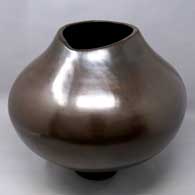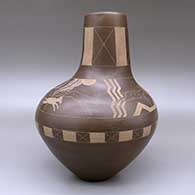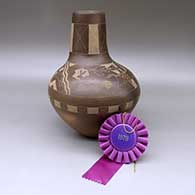
Click or tap to see a larger version
Jody Folwell, Santa Clara, Sienna jar with an off-center neck and a sgraffito moon woman on horse, coyote, deer, bird, rabbit, abstracted landscape, and geometric design; includes a First Award ribbon from the 1978 SWAIA Annual Indian Market in Santa Fe, NM
Santa Clara
$ 3700
josc3k155
Sienna jar with an off-center neck and a sgraffito moon woman on horse, coyote, deer, bird, rabbit, abstracted landscape, and geometric design; includes a First Award ribbon from the 1978 SWAIA Annual Indian Market in Santa Fe, NM
8.5 in L by 8.5 in W by 11.5 in H
Condition: Very good, rubbing and sticker residue on bottom, scratches on sides, and wear around rim
Signature: Jody, with date
Date Created: 1978
Tell me more! Buy this piece!
(505) 986-1234 - www.andreafisherpottery.com - All Rights Reserved
Jody Folwell
Santa Clara

Jody Folwell was born into Santa Clara Pueblo in August, 1942. Her mother was Rose Naranjo, a highly respected Santa Clara potter. Jody and her siblings, Dolly Naranjo, Nora Naranjo, Tito Naranjo, and Rina Swentzell, grew up learning from some of the best traditional potters Santa Clara had to offer. Jody balances that traditional learning with studies in history and political science at the University of New Mexico, finishing with both a BA and an MA. She became an educator and lecturer from the early 1960s through the mid 1970s. It was in 1974 that Jody began making pottery full time.
Early in her career Jody moved away from traditional Santa Clara blackware and redware to create buffware with new forms, styles and colors. She does engraving, incising, carving, cut-outs and painting. Her pottery usually has a political or social message to it, whether that message be about women's rights, children's dreams or whimsical pop art.
In 1987 Jody was chosen as a top contemporary Indian artist by the Southwest Museum in Los Angeles for their major exhibit "Eight Indian Artists II." Among the other artists in the exhibit were Apache sculptor Bob Haozous, Winnebago potter Jacquie Stevens and Navajo painter Clifford Beck, and others. The experience led to years of collaboration with Bob Haozous, son of Apache sculptor Alan Houser.
Jody learned the traditional craft from her mother Rose and she passed that teaching on to her daughters, Polly Rose Folwell and Susan Folwell.
Some Exhibits that Featured Jody's Work
- Something Old, Something New, Nothing Borrowed: New Acquisitions from the Heard Museum Collection. Heard Museum. Phoenix, Arizona. April 2, 2011 - March 18, 2012
- Mothers & Daughters: Stories in Clay. Heard Museum. Phoenix, Arizona. January 10, 2009 - January 10, 2010
- Choices and Change: American Indian Artists in the Southwest. Heard Museum North. Scottsdale, Arizona. June 20, 2007 - April 2012
- Breaking the Mold: The Virginia Vogel Mattern Collection of Contemporary Native American Art. Denver Art Museum, Denver, CO. October 2006 - July 2007
- Breaking the Surface: Carved Pottery Techniques and Designs. Heard Museum. Phoenix, Arizona. October 2, 2004 - October 3, 2005
- The Collecting Passions of Dennis and Janis Lyon. Heard Museum. Phoenix, AZ. May 2004 - September 2004
- Decidedly Diva: Part One, Jody Folwell, Polly Rose Folwell, Susan Folwell. Modo Gallery. Hudson, NY. October 11, 2003 - November 1, 2003
- Changing Hands: Art Without Reservation: Contemporary Native American Art from the Southwest. 2002-2003 Traveling exhibition planned for the following venues: American Craft Museum, New York, NY, 5/9/2002-9/15/2002; Museum of Texas Tech University, Lubbock, TX, 10/13/2002-1/5/2003; Philbrook Museum of Art, Tulsa, OK, 1/19/2003-3/16/2003
- Jody Folwell - Santa Clara: New Works in Clay. Faust Gallery. Scottsdale, AZ. January 31, 2002 - February 7, 2002
- Hold Everything! Masterworks of Basketry and Pottery from the Heard Museum. Heard Museum. Phoenix, Arizona. November 1, 2001 - March 10, 2002
- Images, Artists, Styles: Recent Acquisitions from the Heard Museum Collection. Heard Museum North. Scottsdale, Arizona. July 2001 - January 2002
- The Legacy of Generations: Pottery by American Indian Women. Heard Museum. Phoenix, AZ. February 14, 1998 - May 17, 1998
- The Legacy of Generations: Pottery by American Indian Women. The National Museum of Women in the Arts. Washington, DC. October 9, 1997 - January 11, 1998
- Recent Acquisitions from the Herman and Claire Bloom Collection. Heard Museum. Phoenix, Arizona. January 11, 1997 - July 1997
- Fifth Annual Hollywood Premiere. Four Seasons Hotel, Los Angeles, CA. November 23-24, 1991
- Fourth Annual Hollywood Premiere. Four Seasons Hotel, Los Angeles, CA. November 17-18, 1990
- From This Earth. Museum of New Mexico. Santa Fe, NM. July 1, 1990 - August 30, 1990
- First Annual Indian Arts and Crafts Show: A Juried Competition. Univ. of Kansas Museum of Anthropology. Lawrence, KS. September 16, 1989 - October 28, 1989
- The Pottery of Surprise: New Works by Jody Folwell. Gallery 10, Scottsdale, AZ. March 9, 1989 - March 15, 1989
- Eight Artists II: Contemporary Indian Art at the Southwest Museum. Southwest Museum of the American Indian. Los Angeles, CA. September 27, 1987 - January 5, 1988
- Jody Folwell, Elizabeth Medina, Barbara & Joe Cerno. Gallery 10. Scottsdale, AZ. January 22, 1987 - February 3, 1987
- Everlasting: Four Nationally Prominent Artists. Gallery 10. Scottsdale, AZ. March 6, 1986 - March 19, 1986
- The Santa Fe Indian Market Expanding Exhibit. Morning Star Gallery. Santa Fe, NM. July 26, 1985 - August 31, 1985
- Women of Sweetgrass, Cedar and Sage. Gallery of the American Indian Community House. NY. June 1, 1985 - June 29, 1985
- Indian Market East. Gallery 10. New York, NY. April 12, 1984 - April 28, 1984
- The Ceramics of Grace Medicine Flower & Jody Folwell. Gallery 10. Scottsdale, Arizona. February 24, 1983 - March 9, 1983
- Jody Folwell: Contemporary Pottery. Gallery 10. Scottsdale, Arizona. February 8, 1981 - February 19, 1981
- American Indian Art in the 1980s. The Native American Center for the Living Arts. Niagara Falls, New York. 1981
- Rising Stars. Gallery 10. Scottsdale, AZ. February 8, 1980 - February 27, 1980
- 1978 Heard Museum Guild Indian Arts and Crafts Exhibit. Heard Museum. Phoenix, Arizona. November 24, 1978 - December 2, 1978
- 1977 Heard Museum Guild Indian Arts and Crafts Exhibit. Heard Museum. Phoenix, Arizona. November 25, 1977 - December 3, 1977
Some Awards Jody has Won
- 2018 Santa Fe Indian Market: Native American Art Magazine Editor's Choice Award
- 2018 Santa Fe Indian Market, Classification II - Pottery, Division E - Contemporary Pottery, Any Form or Design, Using commercial clays/glazes, all firing techniques: Best of Division
- 2018 Santa Fe Indian Market, Classification II - Pottery, Division E - Contemporary Pottery, Any Form or Design, Using commercial clays/glazes, all firing techniques, Category 907 - Painted, any form: First Place
- 2018 Santa Fe Indian Market, Classification II - Pottery, Division E - Contemporary Pottery, Any Form or Design, Using commercial clays/glazes, all firing techniques, Category 907 - Painted, any form: Shared Second Place with Diego Romero
- 1993 Santa Fe Indian Market. Classification II - Pottery, Division G. Non-traditional, sgraffito, w/o stones, any color except black, Third Place
- 1989 Indian Arts and Crafts Show: a Juried Competition, Pottery: First Place. University of Kansas Museum of Anthropology. Lawrence, Kansas
- 1988 Santa Fe Indian Market. Classification II - Pottery, miscellaneous, Second Place
- 1987 Gallup Inter-Tribal Ceremonial, Classification IV, Pottery, Bowl, Plate: Best in Classification
- 1987 Gallup Inter-Tribal Ceremonial, Classification IV, Pottery, Bowl, Plate: Best in Category
- 1987 Gallup Inter-Tribal Ceremonial, Classification IV, Pottery, Bowl, Plate: First Place
- 1984 Santa Fe Indian Market, Best of Show
- 1984 Santa Fe Indian Market, Classification II - Pottery, Division G - Non-traditional pottery, new forms, innovations: Best of Division
- 1983 Santa Fe Indian Market, Classification II - Pottery, Division G - Non-traditional, new forms, innovation: First Place
- 1981 Santa Fe Indian Market, Classification II - Pottery: Best of Classification
- 1981 Santa Fe Indian Market, Classification II - Pottery, Division G -Non-traditional pottery: Best of Division
- 1981 Santa Fe Indian Market, Classification II Pottery, Division G - Non-traditional pottery: First Place
- 1978 Heard Museum Guild Indian Arts and Crafts Exhibit, Classification VII - Pottery, Division B - Contemporary: Honorable Mention. Awarded for artwork: Plain sienna vase. Heard Museum. Phoenix, Arizona. November 23, 1978
- 1979 Heard Museum Guild Indian Arts & Crafts Fair, Classification VII - Pottery, First Place 1979 Santa Fe Indian Market, Pottery: Black bowl with butterflies, Second Place
- 1979 Santa Fe Indian Market, Pottery: reclining figure, Second Place
- 1977 Heard Museum Guild Indian Arts and Crafts Exhibit, Classification VII - Pottery, Division B - Contemporary: Honorable Mention. Awarded for artwork: Brown and sienna carved pot
Santa Clara Pueblo

Ruins at Puye Cliffs, Santa Clara Pueblo
Santa Clara Pueblo straddles the Rio Grande about 25 miles north of Santa Fe. Of all the pueblos, Santa Clara has the largest number of potters.
The ancestral roots of the Santa Clara people have been traced to ancient pueblos in the Mesa Verde region in southwestern Colorado. When that area began to get dry between about 1100 and 1300 CE, some of the people migrated eastward, then south into the Chama River Valley where they constructed several pueblos over the years. One was Poshuouinge, built about 3 miles south of what is now Abiquiu on the edge of the Jemez foothills above the Chama River. Eventually reaching two and three stories high, and with up to 700 rooms on the ground floor, Poshuouinge was occupied from about 1375 CE to about 1475. Drought then again forced the people to move, some of them going to the area of Puye (on the eastern slopes of the Pajarito Plateau of the Jemez Mountains) and others downstream to Ohkay Owingeh (San Juan Pueblo, along the Rio Grande). Beginning around 1580 CE, drought forced the residents of the Puye area to relocate closer to the Rio Grande and they founded what we now know as Santa Clara Pueblo on the west bank of the river, with San Juan Pueblo to the north and San Ildefonso Pueblo to the south.
In 1598 the seat of Spanish government was established at Yunque, near San Juan Pueblo. The Spanish proceeded to antagonize the Puebloans so badly that that government was moved to Santa Fe in 1610, for their own safety.
Spanish colonists brought the first missionaries to Santa Clara in 1598. Among the many things they forced on the people, those missionaries forced the construction of the first mission church around 1622. However, like the other pueblos, the Santa Clarans chafed under the weight of Spanish rule. As a result, they were in the forefront of the Pueblo Revolt of 1680. One Santa Clara resident, a mixed black and Tewa man named Domingo Naranjo, was one of the rebellion's ringleaders. However, the pueblo unity that allowed them to chase the Spanish out fell apart shortly after their success, especially after Popé died.
When Don Diego de Vargas came back to the area in 1694, he found most of the Santa Clarans on top of nearby Black Mesa (with the people of San Ildefonso). A six-month siege didn't subdue them so finally, the two sides negotiated a treaty and the people returned to their pueblos. However, successive invasions and occupations by northern Europeans took their toll on all the tribes over the next 250 years. Then the swine flu pandemic in 1918 almost wiped them out.
Today, Santa Clara Pueblo is home to as many as 2,600 people and they comprise probably the largest per capita number of artists of any North American tribe (estimates of the number of potters run as high as 1-in-4 residents).
Today's pottery from Santa Clara is typically either black or red. It is usually highly polished and designs might be deeply carved or etched ("sgraffito") into the pot's surface. The water serpent, (avanyu), is a very common traditional design motif on Santa Clara pottery. Another motif comes from the legend that a bear helped the people find water during a drought. The bear paw has appeared on much of their pottery ever since.
Santa Clara has received a lot of distinction because of the evolving artistry the potters have brought to their craft. Not only did this pueblo produce excellent black and redware, several notable innovations helped move pottery from the realm of utilitarian vessels into the domain of art. Different styles of polychrome redware emerged in the 1920s-1930s. In the early 1960s experiments with stone inlay, incising and double firing began. Modern potters have also extended the tradition with unusual shapes, slips and designs, illustrating what one Santa Clara potter said: "At Santa Clara, being non-traditional is the tradition." (This refers strictly to artistic expression; the method of creating pottery remains traditional).
Santa Clara Pueblo is home to a number of famous pottery families: Tafoya, Baca, Gutierrez, Naranjo, Suazo, Chavarria, Garcia, Vigil, and Tapia - to name a few.



Santa Clara Pueblo at Wikipedia
Pueblos of the Rio Grande, Daniel Gibson, ISBN-13:978-1-887896-26-9, Rio Nuevo Publishers, 2001
Upper photo courtesy of Einar Kvaran, Creative Commons Attribution-Share Alike 3.0 Unported License
Rose Naranjo Family Tree
Disclaimer: This "family tree" is a best effort on our part to determine who the potters are in this family and arrange them in a generational order. The general information available is questionable so we have tried to show each of these diagrams to living members of each family to get their input and approval, too. This diagram is subject to change should we get better info.
- Rose Naranjo (1915-2004) & Michael Edward Naranjo
- Jody Folwell (1942-) & Hank Folwell
- Paul Folwell (1962-)
- Polly Rose Folwell (1962-)
- Jody Sue Folwell (1991-)
- Susan Folwell (1970-)
- Dolly Naranjo-Neikrug (1947-) & Marc Neikrug
- Jody Naranjo (1969-)
- Elijah Naranjo Smith (1978-)
- Nora Naranjo-Morse (1953-) & Greg Morse
- Tito Naranjo & Bernice Suazo Naranjo
- Dusty Naranjo (1968-)
- Forrest Naranjo/Caroline Elliot & Karen Naranjo (Price)
- Johnathan Naranjo (1987-)
- Rina Swentzell (d. 2015)
- Roxanne Swentzell (1962-)
- Edna Romero (moved to Taos Pueblo)
Some of the above info is drawn from Pueblo Indian Pottery, 750 Artist Biographies, by Gregory Schaaf, © 2000, Center for Indigenous Arts & Studies
Other info is derived from personal contacts with family members and through interminable searches of the Internet.
Copyright © 1998-2025 by



